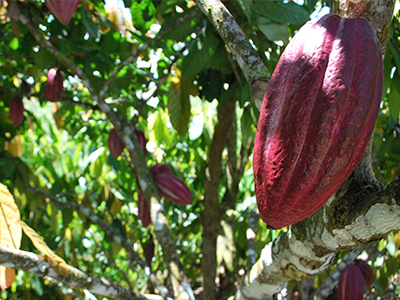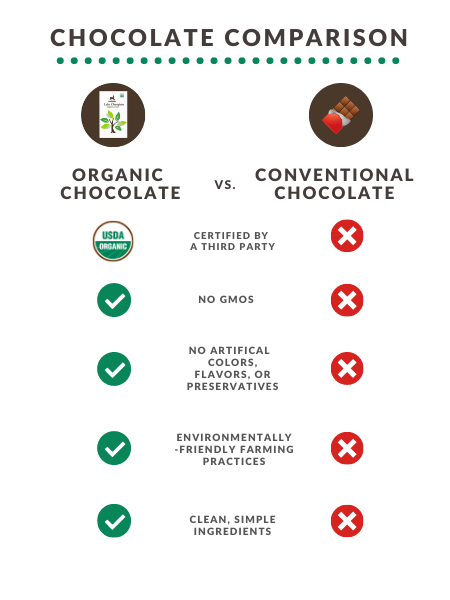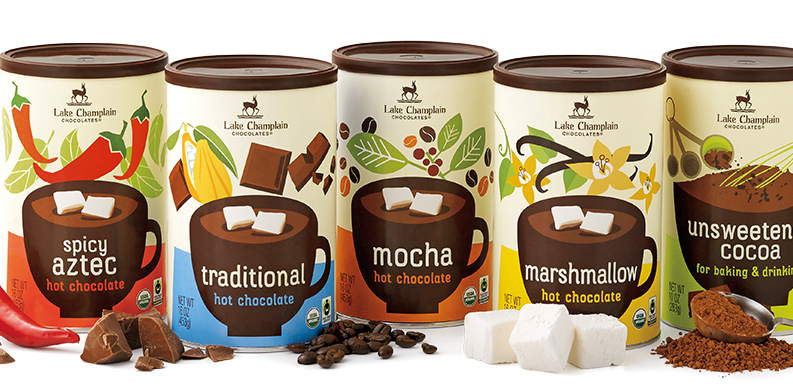What is Organic Chocolate?
Organic chocolate is chocolate that is grown and produced using farming methods, production process, and ingredients that comply with USDA organic standards. To understand what organic chocolate is, we must look at how and where cacao beans are grown and how chocolate is made. All of the ingredients (cocoa beans, sugar, milk, etc.) must be grown or produced without the use of pesticides, herbicides, synthetic fertilizers, or genetically modified organisms (GMOs). When it comes to making organic chocolate, the recipe cannot include artificial ingredients or preservatives. This means organic chocolate is free of artificial flavors, sweeteners, colors, stabilizers, or other synthetic ingredients. Organic chocolate is the best choice for people who want a treat that is made with clean, simple ingredients, and is better for the environment.
Organic Chocolate Farming Practices
Organic chocolate is made from ingredients that are organically farmed on a certified organic farm.
Non-organic or conventional cocoa is one of the highest pesticide-using crops, plus cocoa is grown in countries that don’t have the same strict pesticide and labor regulations that the United States has. Until recently, many cocoa farmers in Africa still used Lindane (a chemical that’s often found in lice shampoo) or DDT on their crop (a harmful pesticide that was banned in the US in 1970s because of its detrimental impact on both humans and the environment).
Cacao trees, the fruit tree that produces cocoa beans, are delicate plants that can be difficult to farm. They require the right balance of sunlight, air, shade, water, and nutrients, and are highly susceptible to disease and insects. It’s estimated that 20-30% of the global cocoa crop is damaged by fungal infection (known as black rot) each year. Plus, over 1500 pests worldwide feed on the cacao tree. Pest or fungal infestations can spread quickly throughout a cacao farm, damaging a large portion of crop.

For farmers who make their living from cocoa crop, pests can be devastating. A low-yield harvest can mean the difference between putting food on the table for the family or not. Therefore, cocoa farmers do everything they can to protect their crops and boost their yield. Unfortunately for conventional cacao, this often equates to a higher use of chemicals.
Organic farmers take a different approach to cocoa farming. Organic regulations ban the use of all artificial pesticides, fungicides and fertilizers, so cocoa farmers must rely on creating sustainable agricultural practices and integrated pest management to protect their crop. Organic cocoa farmers work to create a balanced ecosystem between plants and animals in order to prevent pests and disease. This often means diversifying their crop by using cover crops. Cover crops provide shade for the delicate cocoa trees, while also enriching the soil, providing another source of income for the farmer, and increasing the biodiversity of the ecosystem.
In addition to the strict pest and disease mitigation practices, organic food utilizes an overall farm management system — including incorporating a high level of biodiversity, preservation of natural resources, humane treatment of animals, use of all-natural substances and processes, all while focusing on environmental and animal protection. For organic chocolate and confections, these strict farming practices apply to the cocoa beans, but also to the sugar, milk, maple syrup, nuts, and any other ingredients that get added.
Organic Means Non-GMO
While researchers have been slow to develop a genetically engineered (GE) cocoa bean, there are many other GE ingredients that are found in conventional chocolate. Cane sugar, beet sugar, corn syrup, and soy lecithin (an emulsifier) are often genetically engineered. The National Organic Program (NOP) strictly governs all organic food in the United States. NOP regulations prohibit the use of any ingredient that is genetically engineered (also known as bioengineered foods). This means that the cane sugar must be processed without the use of animal bones (making organic sugar vegan-friendly) and the cows that produce the organic milk in your favorite milk chocolate bar must be raised on non-GMO feed.
Making Organic Chocolate
Organic is a protected term. This means that if a company wants to put the words organic (or the organic symbol) on their package, they must submit their products to be certified. This organic certification goes beyond how the cocoa beans are grown. Strict organic standards, not only USDA standards, but global organic standards are regulated by a third party, such as Quality Assurance International (QAI). This third party organization analyzes and regulates every step in the chocolate making process, including all of the other ingredients that go into the final product. They even regulate the equipment cleaning procedures to ensure that no harsh chemicals are used.

Not only does organic chocolate forbid the use of GMO ingredients, but it also prohibits the use of artificial ingredients, sweeteners, colors, flavors, and preservatives (like hydrogenated fats, high fructose corn syrup, wax, PGPR (an emulsifier), and red 40. Just look at an organic chocolate label and you’ll see nothing but clean, simple ingredients.
Why you should buy organic chocolate
It’s simple to buy organic chocolate – just look for products with the USDA organic seal. In order to display the USDA organic seal on the front of a package, 95% of the ingredients in an organic chocolate bar must be certified organic.
Organic chocolate is often more expensive than non-organic chocolate. The costs of certification in farming and processing increase expenses for both the organic farmer and organic chocolate maker. This results in a finished product that is more costly to produce than conventional, non-organic chocolate. Organic cocoa farmers often opt to certify as both organic and fair trade chocolate. While these are two different certifications, both practices work harmoniously together and deliver their families a higher price point for quality crops.
Chocolate is seen as an indulgence, so most people don’t think about what goes into the foods they are eating. This is why conventional chocolate is so popular. Paying a premium for organic chocolate is a lifestyle choice. It’s for consumers, like yourself, that value the social and environmental impact that their choices have. It’s for people that want to eat chocolate with clean, simple ingredients, while also supporting the environment.
Here at Lake Champlain Chocolates, making extraordinary chocolate is what we do. In the early days, this meant pioneering the movement to create chocolates that were free of additives, preservatives, and artificial colors, flavors and ingredients. As a certified B Corporation®, we use business as a force for good. While our artisan chocolate making process focuses on craftsmanship and a passion for perfection, our ingredient sourcing continues to evolve because better ingredients make better chocolate. It’s that simple. In 2006 we released our very first line of organic chocolate bars. Our organic chocolate selection has grown and now includes chocolate bars, snack bites, and hot chocolate, to chocolate turkeys, snowmen, and even Easter bunnies! That means you and your family enjoy sweet indulgences made with better-for-you ingredients, while being better for the planet!
